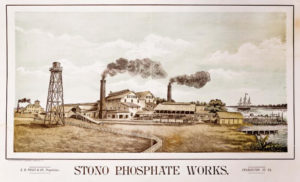Fossils, Phosphate, and Freedmen: Charleston’s Post Civil War Mining Boom at the Charleston Museum
July 2, 2019The Charleston Museum announced a new exhibit from the Museum’s Natural History Collection opening June 29, 2019, Fossils, Phosphate and Freedmen: Charleston’s Post Civil War Mining Boom.
Mining and agriculture are intertwined in the history of the Lowcountry. At the end of the Civil War, the mining of phosphate for use in fertilizers for crops resulted in an economic mining boom in Charleston. At the same time, the economy collapsed in much of the South due to the devastation that the war brought and the emancipation of enslaved people, who no longer provided plantation owners a free labor source. Despite this downturn, phosphate mining brought an infusion of growth from a previously untapped resource.
Due to the close proximity of the mines to Charleston’s port, Charleston was one of the largest producers of phosphorus in the world. An industry spurred from scientific exploration and fossil hunting, Charleston’s reign as king of phosphorus production is a unique window into the relationship between post-Civil War society, paleontology, and natural disaster. Fossils, Phosphate and Freedmen: Charleston’s Post Civil War Mining Boom will explore these relationships as well the chemistry of phosphate and the importance of this finite natural resource. This exhibit will be open June 29, 2019 through February 17, 2020 in The Charleston Museum’s lobby.


















